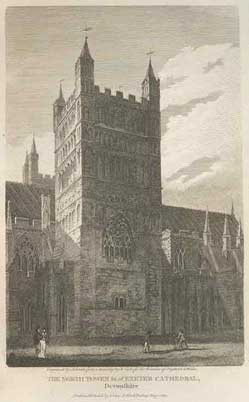GATTERs
OF DEVON, ENGLAND.
.
(Talaton, Heavitree, Upottery, Otterton, Littleham, etc.)
|
Early mentions of this Gatter family at Talaton go back as far as 1569. In that year we find John and Richard Gator in the Muster Rolls listing "all able bodied men over the age of 18". We know little about them and so it is not certain whether they are father and son, brothers, or else. However their first names John and Richard can still be found generations later in this Talaton family, and can thus be called "lead names" which have been passed on from father to son for centuries. The Muster Rolls of 1569 are an account of those who presented themselves, with their accoutrements, at a parade to show the county authorities who and what arms were available in each Hundred for the purposes of defence. |
 |
To the musters came all men between the ages of 16 and 60 together with the arms and armour prescribed for them. The frequency of the musters varied with the perceived danger and varied from once every three years to twice a year. The muster usually covered two days with an interval between them. The deputy lieutenant or a Justice of the Peace presided, with a clerk to note the results. At the end of the first day the men were given a day's pay. On the second day absentees were liable to a fine of forty shillings (£2) or ten days in prison. Additional arms and armour had to be provided by the wealthier residents and the parish vestries.
By the mid 17th century the Gatter family of Tatalon had grown in size and so we find in the Protestation Oath Returns of 1641 five male Gater/Gatter above the age of 18.
|
Brief History of Talaton "TALATON, or Tallaton, a village on a northern declivity, 3 1/2 miles N.W. of Ottery St. Mary, and 11 miles N.E. of Exeter, has in its parish 462 souls, and about 2250 acres of land, rising to a bold eminence, which overlooks the Otter valley, and including 140A. of waste, and the hamlets of Larkbeare, Escot, Talewater, and Fairmile, and several scattered houses. Sir John Kennaway, Bart., is lord of the manor and owner of a great part of the soil, and has a handsome seat here, called Escot House, built on the site of the old mansion, which was erected about 1688, and was destroyed by fire, on Dec. 28th, 1808, . . . J.P. Mathew, Esq., owns part of the parish, and resides at Ridon House; and Mr. R. Pratt and a few smaller freeholders have estates here. The Church (St. James,) has a tower and five bells, and contains a rich screen, and some memorials of the Eveleigh and other families. The rectory, valued in K.B. at £32. 3s. 1 1/2d., and in 1831 at £581, is in the patronage and incumbency of the Rev. L.P. Welland, who has 62A. 1R. 1P. of glebe, and a rent-charge in lieu of tithes. . . ." [From White's Devonshire Directory (1850)] |
|
|
The first tracable ancestor of this Talaton family is Richard Gatter, born likely around 1610 in Talaton, Devon. He married on 16 Apr. 1638 at St Sidwells, Exeter and died on 04 Nov 1655 at Talaton (his death could however also be on 15 Jul 1689 or 13 Mar 1691. His wife was Dorothy Lee, died on 30 Sept 1657 at Talaton. In the following decades the family spreads to the neigboring villages of Heavitree (1733), Plymtree (1736), Combe Raleigh (1775), Upottery (1777), Colaton Raleigh (1786), Otterton (1810), Farringdon (1816), Plymouth (1851), Littleham (1865), Honiton (1871), in Ottery St. Mary (1873), Exmouth (1897), and Budleigh Salterton (1940). If you want to know more about these towns, then consult the GENUKI gazeteer of Devon. But Members of the family also soon left Devon. In the early 19th century we find them in Wales and Gloscester in the towns of Michaelstone-Y-Fedw, Monmouthshire, Wales (1804), Bristol, Glos. (1810), and Cardiff, Glamorgan (1813). In the second half of the 19th century members of this family left England for Australia and America (see below).
|
By the late 18th century the Gatter branch that is of interest here lived in Upottery.
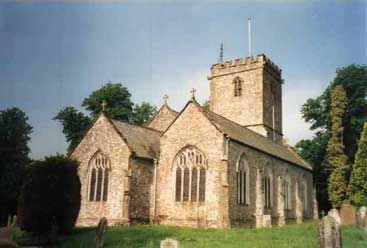 |
 |
|
Brief History of Upottery "UPOTTERY, or Up-Ottery, is a pleasant village, in the picturesque valley of the river Otter, a few miles from its source, and 5 miles N.E. by N. of Honiton, Its parish contains 991 souls, and 5830A. 3R. 23P. of land, including the Rawridge tithing, and manthe y scattered farms, and extending to the borders of Somersetshire. Here is a cattle fair on October 17th, and an annual ploughing match. Viscount Sidmouth is lord of the manor and owner of a great part of the parish, and resides at the large new Manor House, which has been lately erected at great expense. . . . The manor was given by the Conqueror to Ralph de Pomeroy, and was afterwards given to the church of Rouen, from which it passed to Sir Nicholas Cheyney, in the reign of Henry III. It afterwards passed to the Willoughby, Blount, and Popham families, and was purchased of the latter by Dr. Addington, father of the late Viscount Sidmouth. The CHURCH (St. Mary,) is a fine antique structure, with a tower and five bells. . . . The Dean and Chapter of Exeter are patrons of the vicarage, . . . The Rev. George Lowe, M.A. is the vicar, and in 1843'-4, erected a new Vicarage House, in Elizabethan style, at the cost of about £1600. . . ." [From White's Devonshire Directory (1850)] |
The ancestor of this line is Francis Gatter, born around 1780.
He is likely to be identical with the Francis Gatter born on February
8, 1780 in Upottery as son of Robert Gatter and Elizabeth Gooding.
Francis Gatter left Devon and settled in Wales. He married Cecilia Spooner on 22 Dezember 1804 in Michaelstone-Y-Fedw, a little village which is just on the outskirts of Cardiff, Wales. Cecilia Sponer She was born in 1787 in Michaelstone-Y-Fedw, Mon.. They had eight children (see below). Francis Gatter died 1852 in St Phillips & Jacob, Bristol, Gloscester.
|
About
Michaelstone-Y-Fedw, Douglas Mumma writes: |
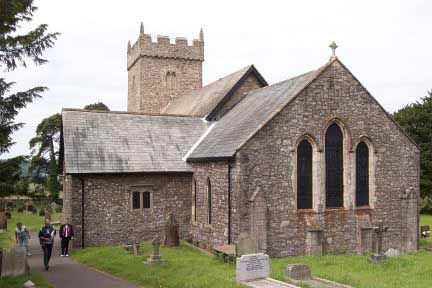 |
|
| FF |
5th century
parish church in Michaelstone-Y-Fedw |
 |
FFF | 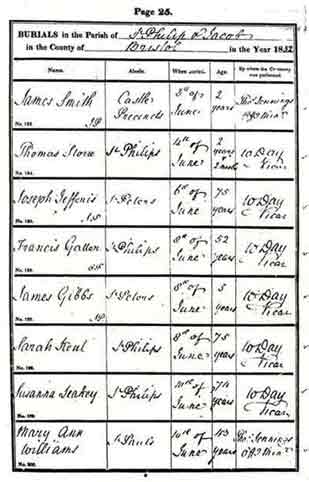 |
|
Marriage
of Francis Gatter (at top)
(courtesy of Mike John) |
|
Burial
of Francis Gatter (middle) |
One of Francis' children, William Gatter, was born on 6 Oktober 1805 in Michaelstone-Y-Fedw, Mon., and died on 4 März 1888 in Walcot, Bath, Somerset, England.
|
He married Elizabeth Powell on 9 September (born 1804, died 1867 in Bridgwater, Somerset). From birth records, we know the family moved from Bristol to Bridgewater between 1841 and 1845. Here they lived at 49 North Street. It is a nice little building with a blue door (see photo), conveniently located accross from a pub, as his descendant Joan Gatter and husband Doug Mumma could establish during their 2001 summer trip to the old country. |
 |
|
|
Home of
William Gatter in the 1850s in Bridgwater, Somerset |
|
Douglas Mumma writes (www.mumma.org): Of the descendents of William Gatter (1805-1888), the eldest four migrated to Australia. Among them was George Prowlin Gatter who landed in Melbourne. The specific place was called "Box Hill", which is probably a suburb of Melbourne. George emigrated from England to Australia on the ship, "Ben Nevis". He left Liverpool 22 Jun 1855 and arrived in Victoria 4 Oct 1855. There he established the "London" Nursery in Box Hill in 1861. He is buried in the Box Hill cemetery. Interesting that he continued in his father's footsteps of raising plants, just as his last remaining descendant in Australia who uses the Gatter surname. |
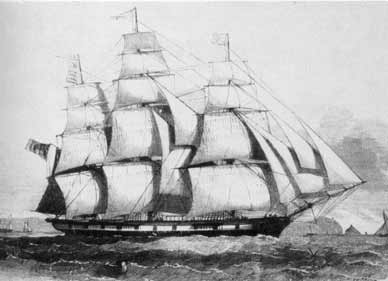 |
 |
BEN NEVIS The "Ben Nevis" was the first ship owned by Pilkington & Wilson's White Star Line of Liverpool. She was however, too short and deep for her tonnage, her measurements being:- Length overall 181ft; Beam 38ft 6ins; Depth of hold 28ft; Registered tonnage 1420. Commanded by Captain Heron, she sailed for Melbourne on 27th Sept.1852, with 600 passengers, a cabin passage in her costing L25, and she took 96 days going out. She was built in 1852 by W & R Wright & Smith of Nova Scotia, and ended up in the 1870's on the St Lawrence - Liverpool timber trade. (above the ship Ben Nevis, on the left Melbourne around 1880). |
Francis William Gatter (1841-1903) was the only one to end up in America, and four younger children remained in England.
|
Francis W. Gatter was quite a character who gave us fits trying to find out much about him.As is a common practice with sailors, which he was, he was prone to telling tall tales.After awhile, we think he began to believe them. We know he left England about 1857 as a sailor engaged in "packet service" between England and various ports.In 1861 he was aboard the ship, GOOD HOPE, near Ft. Sumpter in Savannah, Georgia, the day before the American Civil War started.The merchant ships were offered the opportunity to join the Southern Navy or get out of the harbor immediately.Francis decided to stay on his ship and return to New York.There he decided to enlist in the U.S. Navy. However, after signing up, he found out he would be on a little gun boat for one year, but men were offered 3 year enlistments on the big ships. Picture of Francis W. Gatter (courtesy of Doug Mumma) Source: "Marine History of the Pacific Northwest" by Lewis & Dryden. Edited by E.W. Wright. Antiquarian Press, LTD. New York 1961. page 166. |
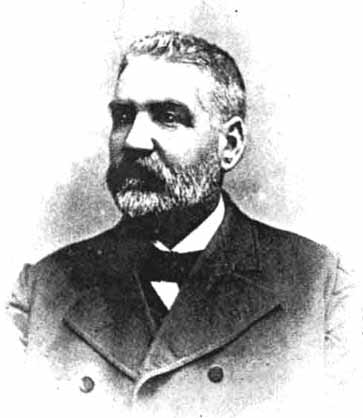 |
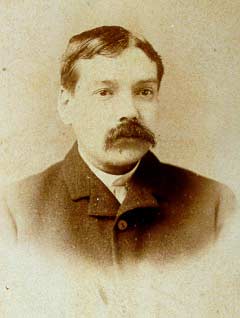 |
Well, Francis loved sailing so he literally traded places with a "3 year" sailor by the name of John Henry.They traded their sea bags and complete identities - names and all. So Francis served for a year under the name of "James Henry" until he was mustered out because of ill health. He immediately resumed using his old name, Francis Gatter, but retained his "new" place of birth, New York. I guess it was easier that way and he didn't have to go thought the immigration process by simply saying he was born in America. Also, he revised his birth year by 3 years, again for unknown reasons. All of this came to light when in 1890 he applied for an "invalid Navy pension" and his previous exploits became known and he confessed all. All of this information is contained in the American National Archives in a very thick file. A photograph of Francis (see left) can be viewed at this URL which is a tribute to men and women who have served in the US armed services (go to http://www.lonesailor.org/log.php and enter the name of GATTER and click on Francis' name. | |
|
Francis Gatter in 1861 in Boston,
MA.
|
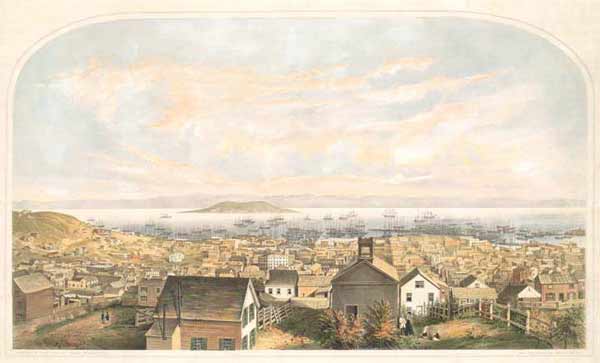 |
|
For many years in the late 1800s, Francis Gatter traveld as Captain of different coastal ships up and down the West Coast, the family lived first in San Francisco (above) and then in Tacoma (see below). Before they settled in Oakland, Ca. (below). |
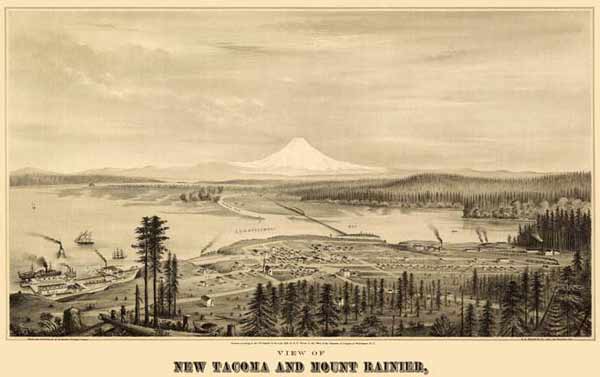 |
The Gatter family finally settled in Oakland, California (see pictures below).
 |
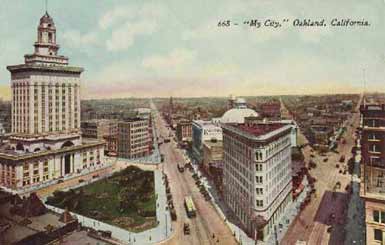 |
For more information on this line consult http://www.mumma.org, and the pedigree chart at http://www.mumma.org/pedigree/jfm_001.html.
Copyright: Gatter
Archive 2000-2008
Any distribution and use of material displayed on the Gatter History Archive
Web Page
other than for personal purposes will be prosecuted
Contact
